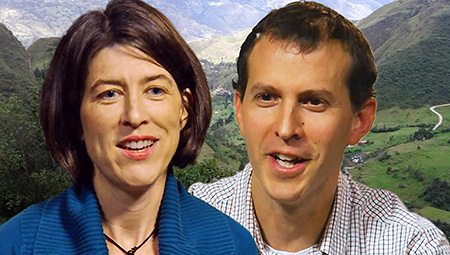
Faculty - Student Research Project: Beyond the Treeline

If the government pays poor villagers not to use land for farming, will communities voluntarily protect the environment? Will people change their behaviors if they have an incentive to protect essential forests even if it threatens their livelihoods? These are questions Professors Tanya Hayes and Felipe Murtinho and their student researchers are seeking to answer for the government of Ecuador.
The paramo, a vital but fragile ecosystem in the high Andes, supplies water to all of Ecuador and other parts of South America. For centuries, peasant communities have used its grassland and meadows to meet their basic needs. As population grew, villagers burned sections of the paramo to increase land for animal farming. Because of changes to the ecosystem from burning and overgrazing, the paramo now has depleted soils and diminished capacity to store water.
"The pramo is threatened, and without this vital ecosystem, the future of water in Ecuador is at stake," said Professor Tanya Hayes, who teaches environmental studies and public policy.
The high Andes communities that use the paramo are extremely poor, with no running potable water and very limited access to good health care and education. Families may have a small area to grow their own potatoes and vegetables, but communities collectively use the upper part of the mountains, the paramo, for farming cows, sheep, and alpacas.
To protect the paramo, the Ecuadorian government has put in place a voluntary "payment for conservation" policy. The government pays peasants to stop cattle grazing and burning.
"Participating communities have used their payments to rebuild schools, invest in community services, and improve food production through guinea pig farming," said Professor Murtinho, who teaches in the International Studies Department and Master of Public Administration program.
With a National Science Foundation grant, Hayes and Murtinho are evaluating the impact of the policy. They conducted field studies in 67 communities, 44 participating in the program and 23 not participating. The researchers interviewed community leaders and surveyed households to determine whether the cost and benefits of participation impacted land use behavior. Assisted by Seattle University student researchers, they also offered valuable workshops to those communities seeking more income-producing activities.
"Several communities are extremely interested in becoming ecotourism sites, and our students are helping them decide how to do that," Hayes said. "Students led discussions about the advantages and disadvantages of ecotourism, what communities might have to offer as an ecotourism location, what they might need to do to be successful, and what marketing efforts they would be required to make. This type of participatory workshop gave our students a valuable experience in how to conduct work in rural areas."
Back on campus this fall, students assisted with the hard work of statistical analysis and mapping the data, putting into practice what they've learned in class. Senior Taylor McDowell found that his coursework in Environmental Studies and Geographic Information Systems gave him both the theoretical framework and the technical tools to work on a project like this.
"There's nothing quite like actually conducting the research itself that would prepare you for the professional world," he said. "I was able to apply standard technical research practices and methodologies in an actual research situation while using the classroom concepts and theories that I learned."
When the project is completed in June 2015, Hayes and Murtinho will present their findings to Ecuador?s Ministry of the Environment, regional agencies, and fellow researchers.
"Frequently people are looking for win-win solutions, and those solutions are not easy," Hayes said. "The project in Ecuador is a good example of a strong program that links conservation and benefits. While it's too soon to see if the policy is a success, we can determine whether there have been positive behavioral changes. That would be progress, but still there is work to do."
Watch the video: